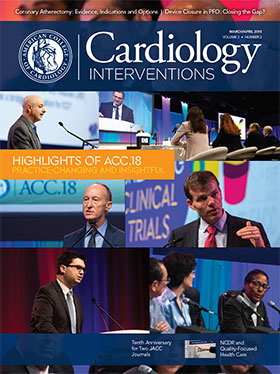Peripheral Matters | COMPASS Points to Benefits of Rivaroxaban, Aspirin Combination to Treat Lower Extremity PAD
Findings from the COMPASS Trial presented at ACC.18 suggest that the combination of low-dose rivaroxaban and aspirin significantly lowers the incidence of both major adverse cardiovascular events (MACE) and major adverse limb events (MALE) in patients with lower extremity peripheral artery disease (PAD). The results were presented by Sonia Anand, MD, in a Featured Clinical Research session and simultaneously published in the Journal of the American College of Cardiology.
The study analyzed outcomes in 6,391 patients with lower extremity PAD who were randomized to receive either a low-dose rivaroxaban (2.5 mg/twice daily) and aspirin combination, rivaroxaban alone, or aspirin alone. Researchers assessed whether hospitalizations, MACE, amputations and deaths were higher after the first episode of MALE compared with PAD patients who did not experience MALE. They also studied the impact of treatment with low-dose rivaroxaban and aspirin compared with aspirin alone on the incidence of MALE, peripheral vascular interventions, and all peripheral vascular outcomes over a median follow-up of 21 months.
Researchers found the independent predictors of MALE included “severe ischemia symptoms at baseline, prior limb or foot amputation at baseline, prior history of peripheral revascularization surgery or angioplasty, and randomization to the aspirin arm of trial.” They noted that diabetes, smoking, female sex and history of CAD were not independently predictive of MALE. Overall, the incidence of MALE was highest (3.8 percent) in PAD patients with a prior history of intervention (i.e., peripheral revascularization or amputation) and lowest (0.5 percent) in patients with asymptomatic PAD (ABI <0.90).
According to the researchers, 128 patients experienced MALE, putting them at significantly increased one-year cumulative risk of subsequent hospitalizations (95.4 percent), amputations (22.9 percent) and death (8.7 percent). However, compared with aspirin alone, the combination of rivaroxaban and aspirin lowered the incidence of MALE by 43 percent (p=0.01), total vascular amputations by 58 percent (p=0.01), peripheral vascular interventions by 24 percent (p=0.03) and all peripheral vascular outcomes by 24 percent (p=0.02).
Of note, researchers said that “while the risk of death did not change after a MALE event in participants randomized to receive rivaroxaban and aspirin combination, there was a six-fold risk of death after a MALE event for participants randomized to receive aspirin alone.” Similarly, the risk of composite MACE or total vascular amputation in participants randomized to receive aspirin alone was 10-fold following a MALE.
“Among individuals with stable lower extremity PAD, the development of MALE is associated with a dire prognosis, making its prevention of utmost importance,” researchers said. As such, they urged consideration of low-dose rivaroxaban and aspirin “as an important therapy for patients with PAD.”
Keywords: ACC Publications, Cardiology Interventions, Peripheral Arterial Disease, Aspirin, Incidence, Follow-Up Studies, Random Allocation, Lower Extremity, Angioplasty, Amputation, Ischemia, Diabetes Mellitus, Prognosis, Hospitalization, Smoking
< Back to Listings

